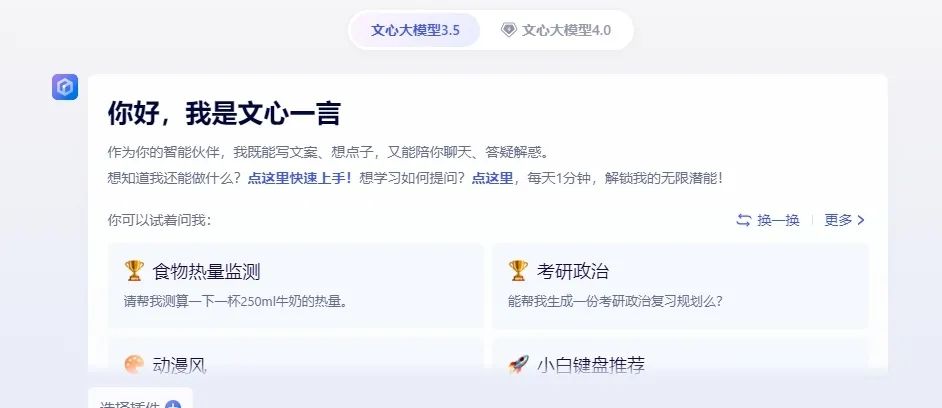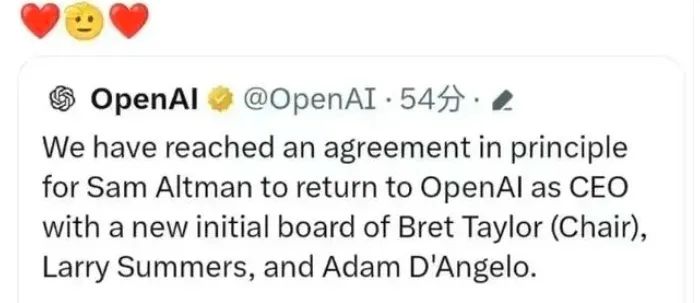Source: Big Model Home

Image Source: Generated by Wujie AI
In 2023, the hotspots of the artificial intelligence track have emerged frequently, providing a continuous source of power for the global economic recovery and social progress. Within this track, a series of new technologies and achievements revolving around AI have been landing successively, and big models have entered a new era of accelerated iteration and upgrade. As an important participant in the AI field, Big Model Home has been tracking the cutting-edge research and exploration of AI. Through channels such as AI Fresh News Daily, we timely deliver the latest news in the AI field to users and deeply explore the stories behind each technological breakthrough in original headlines. At the end of the year, we have specially summarized the top ten events in the AI field from a massive amount of research, to witness together this extraordinary year for AI.
1. OpenAI Releases ChatGPT-4
On Tuesday, March 14, Eastern Time, OpenAI announced the launch of the large multimodal model GPT-4, claiming that it can take in image and text inputs, and output text that is "more creative and collaborative than ever before," and that "due to its broader common sense and problem-solving abilities, it can more accurately solve difficult problems." OpenAI stated that GPT-4 can simultaneously analyze text and images, allowing it to interpret more complex input content.
2. Baidu's Wenxin Yiyuan Emerges, Kicking Off the Battle of Big Models
On March 16, Baidu officially released the new generation large language model Wenxin Yiyuan (English name: "ERNIE Bot"), which is another generative AI product launched by Baidu following Wenxin Yige. It is reported that Wenxin Yiyuan is mainly divided into two parts, one of which is consumer-oriented. Wenxin Yiyuan is embedded in Baidu search, allowing users to interact directly with the large language model, which will complement and even upgrade the traditional search experience, potentially forming new traffic entry points, attracting more users, and gaining market share, while empowering Baidu's platform advertisers, content creators, and merchants.
Subsequently, Huawei's Pangu, 360 Brain, SenseTime Ririxin, Alibaba's Tongyi Qianwen, JD's Yanxi, Kuaishou's Wanjing Tiangong, iFLYTEK Xinghuo, and Tencent's Hunyuan… Large AI models successively made their debut, and the battle of large models began.
On October 17, at Baidu World 2023, Li Yanhong delivered a speech on "Teaching You to Make AI Native Applications" and released the Wenxin large model 4.0 version, bringing more than ten new AI native applications such as new search and new maps.

Image Source: Internet
3. AI Sun Yanzi Sweeps the Internet, AI Singers Experience a Boom
In May 2023, on major video platforms, "obscure singer Sun Yanzi" used various AI "avatars" to sing different genres of songs, from pop to rock, and even "bizarre" styles. AI Sun Yanzi can do it all. In addition to AI Sun Yanzi, through AI avatars, well-known singers and bands such as Eason Chan, Jay Chou, and The Beatles "reappeared" on Bilibili and released "new songs." Jay Chou sang Japanese songs, Teresa Teng performed "The Clock in the Opposite Direction"… Everything seemingly impossible can be achieved by AI singers.
4. Multiple Education Companies Enter, AI Opens up New Formats for Education
With the iteration of large models, AI education applications have made breakthroughs. In May 2023, iFLYTEK released the Xinghuo Cognitive Large Model 1.0. The cognitive large model is based on the Xinghuo large model architecture and can achieve AI homework correction, AI spoken dialogue, and other capabilities. Subsequently, iFLYTEK has made multiple upgrades in the field of large models + education, covering software capabilities on the model side, hardware improvements for learning machines, as well as solutions for the G-end and B-end markets. In July, NetEase Youdao launched the "Ziyue" Education Large Model, and subsequently released a series of applications featuring the "Ziyue" Education Large Model, including spoken language coach Hi Echo, LLM translation, AI essay guidance, grammar explanation, AIBox, document Q&A, and more. On November 4, NetEase Youdao's "Ziyue" Education Large Model passed the relevant filing. Among the batch of filings, there is also the MathGPT large model under the Good Future, which has transitioned from the internal testing phase to full external release, and has launched functions including AI dialogue learning, AI problem-solving assistant, and Chinese-English writing assistant on learning machines. Earlier, ZuoYeBang also released the Yinhe large model, hoping to cover large model capabilities in multiple subjects and stages.
5. Mobile Phone Manufacturers Enter the Large Model Arena
In July of this year, Huawei announced the industry-oriented Pangu Large Model 3.0 at the Developer Conference, with the highest version reaching 100 billion parameters, and officially announced that the new generation intelligent operating system HarmonyOS 4 has integrated the Pangu Large Model, and Xiaoyi has become the first terminal voice assistant with large AI model capabilities. In September, Huawei announced the beta testing of the large model version of Xiaoyi, with the first batch of supported models being the Mate 60/P60 series phones. In August 2023, Xiaomi announced that it has successfully self-developed a 13 billion parameter edge-side model, and has achieved operation on mobile phones. It also announced its self-developed large-scale pre-training language model MiLM-6B, with a parameter scale of 64 billion, ranking first in the authoritative Chinese evaluation rankings C-EVAL and CMMLU among large models of the same parameter scale. Similarly, on November 16, OPPO officially released the independently trained personalized exclusive large model and intelligent body AndesGPT at the Developer Conference. AndesGPT is based on the "end-cloud collaboration" infrastructure design concept and has launched models of various parameter scales from billions to over a trillion. In addition, Honor phones have begun to lay out, and it is expected to integrate large model capabilities into the phone OS in January next year.
6. AI Large Models "Get on Board" at the Right Time
In August 2023, GAC Group announced the official launch of the latest R&D achievement of AI large model technology—the GAC AI Large Model Platform, and Geely Auto also stated that the first full-stack self-developed all-scenario AI large model will be installed on the Geely Galaxy L6. Earlier, Chery New Energy Automobile registered the "ICAR GPT" trademark, and Great Wall Motors registered the "Great Wall Motors SPACEGPT" and other trademarks, while NIO, XPeng, and other car companies also applied to register GPT-related trademarks. In addition, many car companies have announced cooperation with large model enterprises: Baidu Apollo recently announced that Great Wall Motors and Yikatong Technology have become the first batch of partners to explore applications of the Wenxin large model smart cabin; in April this year, Geely Auto, Zhiqi Auto, Chery New Energy Automobile, and many other companies also stated that they will cooperate with Alibaba Cloud in large model-related scenarios.
7. First "Artificial Intelligence Law Demonstration Law 1.0 (Expert Draft)" Released
August 15, the drafting group of the major project "Research on the Construction of China's Artificial Intelligence Ethics Review and Regulatory System" of the Chinese Academy of Social Sciences released the "Artificial Intelligence Law Demonstration Law 1.0 (Expert Draft)". It is reported that the "Demonstration Law" covers seven major chapters including general principles, support and promotion of artificial intelligence, management system for artificial intelligence, obligations of artificial intelligence developers and providers, comprehensive governance mechanism for artificial intelligence, legal responsibilities, and appendices. Overall, the "Demonstration Law" adheres to the Chinese governance approach of parallel development and security, proposing governance systems such as negative list management, and addressing core issues such as the allocation of responsibilities and obligations of various entities in the artificial intelligence industry chain. In the "Artificial Intelligence Law Demonstration Law 1.0 (Expert Draft)", experts emphasize promoting the widespread application of artificial intelligence through the pioneering efforts of state organs, using a negative list management system for risk management of artificial intelligence, implementing a licensing mechanism for research and development and provision activities within the negative list, and implementing pre-approval supervision; research and development and provision activities outside the negative list are subject to a filing mechanism and post-approval supervision, and it is proposed to establish a "national authority for artificial intelligence, responsible for coordinating the development and management of artificial intelligence", while relevant departments should adhere to a development-oriented approach and design corresponding clauses such as due diligence exemption to provide a relaxed policy environment for artificial intelligence innovation activities.
8. Sam Altman's "Resignation" Controversy
On November 17, OpenAI announced that founder Sam Altman will "depart" (a neutral term for dismissal) from the positions of CEO and director. The reason is that Sam was not consistently "candid" in his communication with the board, and Mira Murati (former CTO) temporarily took over as CEO. It took immediate effect. Just one day later, on the 19th, OpenAI investors pressured the board to demand Sam Altman's return as CEO. Ultimately, at 1:00 am New York time on November 22, OpenAI officially announced on X's (formerly Twitter) official account that it had tentatively agreed for Sam Altman to return to OpenAI as the company's CEO. At the same time, there was a major change in OpenAI's board of directors, with the new board including Bret Taylor (Chair), Larry Summers, and Adam D'Angelo.

Image Source: Internet
9. NVIDIA Releases AI Chip H200
In November 2023, chip giant NVIDIA announced the successor to the H100 chip, the world's most powerful AI chip to date—H200, at the 2023 Global Supercomputing Conference (SC2023). It is reported that compared to its predecessor H100, the performance of H200 has directly increased by 60% to 90%. At the same time, H200 is also NVIDIA's first chip to use HBM3e memory, with faster speed, larger capacity, and more suitable for training or inference of large language models. The wave of large models has also allowed NVIDIA to earn a lot of money. As of the second quarter report as of July 30, 2023, NVIDIA's revenue was $13.51 billion, a 101% year-on-year increase; net profit was $6.188 billion, an 843% year-on-year increase. NVIDIA's good performance is not only reflected in its financial performance, but its stock price has also continued to rise this year. Since the beginning of the year, NVIDIA's stock price has more than tripled, with a current total market value of $1.22 trillion.
10. Gemini Large Model's Popularity and Google's Fabrication Controversy
On December 6, Google officially announced the release of Gemini 1.0, which it considers to be the largest and most powerful artificial intelligence model, capable of processing information in various forms such as video, audio, and text. It is reported that Google has released three different versions for different scenarios: Gemini Ultra, the largest and most powerful model suitable for highly complex tasks; Gemini Pro, the best model for various tasks; Gemini Nano, the most efficient model on edge devices. However, the heat did not last long, as a video demonstrating Gemini's powerful capabilities released by Google was questioned for being fabricated, causing the company to be embroiled in a "false advertising" controversy. Faced with the questioning, Google also confirmed to the media that the video demonstrating Gemini's performance was not real-time, but used still image frames from the original footage, with text prompts written to elicit a response from Gemini.
In Conclusion
There is no doubt that 2023 was a crucial year for artificial intelligence. It not only demonstrated a huge leap in technology but also heralded profound changes in society and culture. The progress of AI is not only a technological innovation but also reshapes our daily lives, work methods, and even modes of thinking at a deep level. From the widespread application of ChatGPT to the new discussions sparked by Google's Gemini, the rise of these technologies has led to in-depth reflections on ethics, privacy, employment, and innovation. Looking ahead, the challenge we face is to find a balance in this technological revolution, fully harnessing the advantages of AI while effectively addressing the problems it may bring. The experiences and achievements of 2023 are our guiding light for moving forward, allowing us to proceed with caution in the development of the AI era. We will continue to explore the possibilities of harmonious coexistence between AI and human society, ensuring that technological progress truly benefits everyone.
免责声明:本文章仅代表作者个人观点,不代表本平台的立场和观点。本文章仅供信息分享,不构成对任何人的任何投资建议。用户与作者之间的任何争议,与本平台无关。如网页中刊载的文章或图片涉及侵权,请提供相关的权利证明和身份证明发送邮件到support@aicoin.com,本平台相关工作人员将会进行核查。




